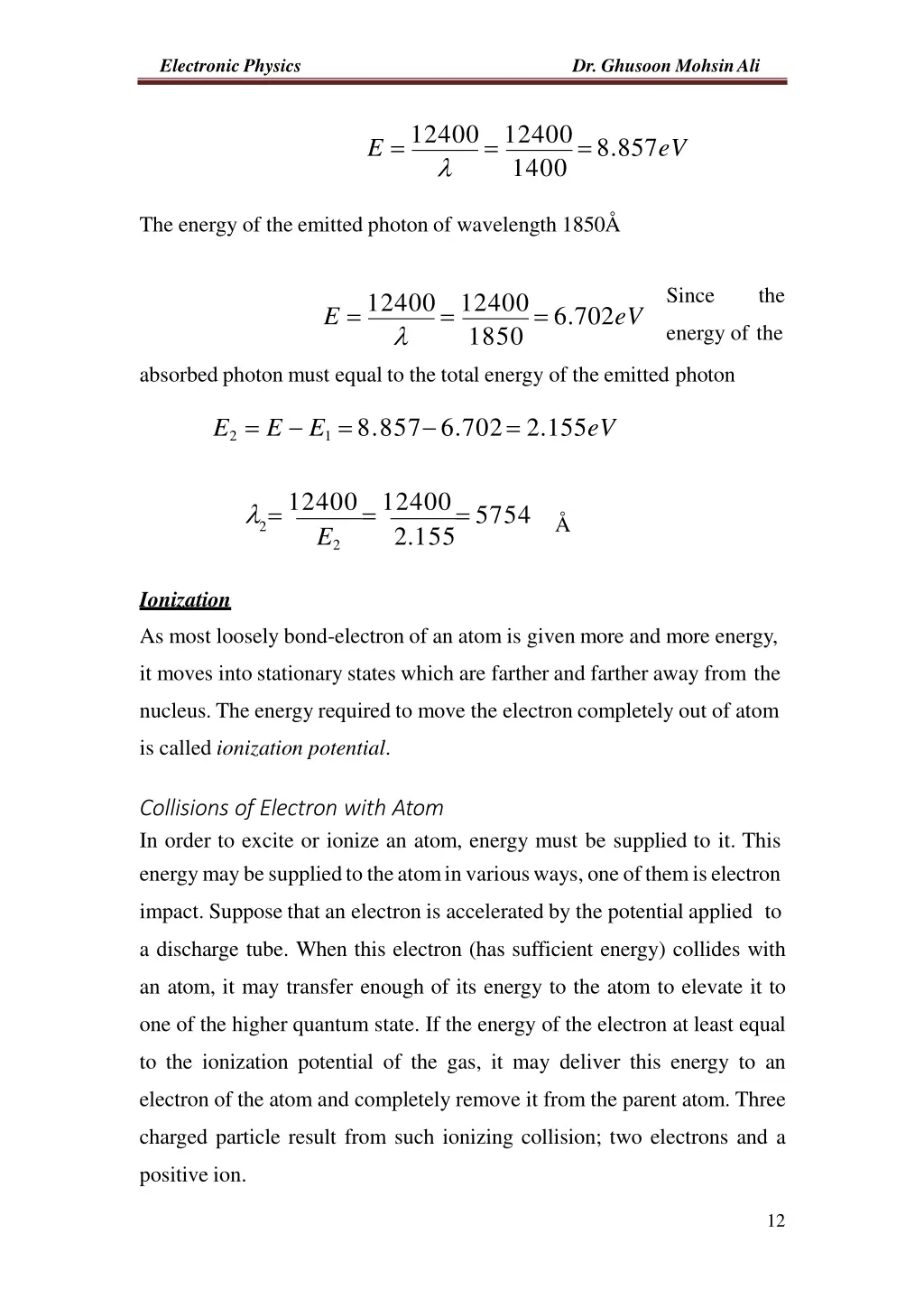
Electronic Physics and Excitation Mechanisms
Explore the principles of electronic physics, including ionization, photon interactions with atoms, and the dual nature of matter. Learn about collisions involving electrons and atoms, as well as the significance of photon energy levels in excitation processes.
Download Presentation

Please find below an Image/Link to download the presentation.
The content on the website is provided AS IS for your information and personal use only. It may not be sold, licensed, or shared on other websites without obtaining consent from the author. If you encounter any issues during the download, it is possible that the publisher has removed the file from their server.
You are allowed to download the files provided on this website for personal or commercial use, subject to the condition that they are used lawfully. All files are the property of their respective owners.
The content on the website is provided AS IS for your information and personal use only. It may not be sold, licensed, or shared on other websites without obtaining consent from the author.
E N D
Presentation Transcript
Electronic Physics Dr. Ghusoon MohsinAli E =12400=12400=8.857eV 1400 The energy of the emitted photon of wavelength 1850 Since the E =12400=12400= 6.702eV energy of the 1850 absorbed photon must equal to the total energy of the emitted photon E2= E E1=8.857 6.702= 2.155eV =12400=12400= 5754 2 2.155 E2 Ionization As most loosely bond-electron of an atom is given more and more energy, it moves into stationary states which are farther and farther away from the nucleus. The energy required to move the electron completely out of atom is called ionization potential. Collisions of Electron with Atom In order to excite or ionize an atom, energy must be supplied to it. This energymaybesuppliedtotheatominvariousways,oneofthemiselectron impact. Suppose that an electron is accelerated by the potential applied to a discharge tube. When this electron (has sufficient energy) collides with an atom, it may transfer enough of its energy to the atom to elevate it to one of the higher quantum state. If the energy of the electron at least equal to the ionization potential of the gas, it may deliver this energy to an electron of the atom and completely remove it from the parent atom. Three charged particle result from such ionizing collision; two electrons and a positive ion. 12
Electronic Physics Dr. Ghusoon MohsinAli Example (a) What is the minimum speed of an electron in order that a collision between it and a neon atom may result in ionization of this atom? (b) What is the minimum frequency that a photon can have to cause a photoionization of neon atom? Note: The ionization potential of neon is 21.5eV Solution (a) The energy of bombared electron or photon must be at least equal to ionization potential mv2 E = 2 k mv2 = 21.5 1.602 10 19 J 2 2 21.5 1.602 10 19 J 9.109 10 31 v = = 2.74 10 m/ s. 6 (b) =12400=12400= 576.74 E 21.5 3 108 c f = = = 5.2 10 Hz 15 576.74 10 -10 Collisions of Photon with Atoms An Atom may absorb a photon of frequency f and thereby move from the level of energy E1 to E2where E2 = E1 + hf 13
Electronic Physics Dr. Ghusoon Mohsin Ali An extremely important feature of excitation by photon capture is that the photon will not be absorbed unless its energy corresponds exactly to the energy difference between two stationary levels of the atom with which it collides. If the frequency of the photon is sufficiently high, it may have enough energy to ionize the gas. The photon vanishes with the appearance of an electron and a positive ion. If the photon has more than ionizing energy of the excess will appear as the kinetic energy of the emitted electron. The Dual Nature of Matter In 1924 de Broglie postulated that all matters behave like a wave =h=h mv p Where p is the momentum of mass Example Calculate the de Broglie wavelengthof (a) a ball of mass 0.5 kg traveling at 0.016m/s (b)a dust particle of mass 1 10-4 kg traveling at 0.1 m/s (c ) an electron traveling at 5 105m/s Solution =h=h mv p (a) =6.626 10-34 = 8.28 10 32 m (b) 0.5 0.016 -34 =6.626*10 = 29 6.26*10 m 10-4 *0.1 14
Electronic Physics Dr. Ghusoon MohsinAli (c) 6.626*10-34 = =1.4*10 m 9 9.109*10-31 *5*105 ----------------------------------------------------------------------------------------- The kinetic energy is given by the formula m.v2 Ek= 2 Also the kinetic energy is obtained from the accelerating voltage V Ek =eV h =( 2meV) 1/2 Example Calculate mass contained in red light of wavelength 7 10-7m which hits an electron at rest the energy contained in the light wave is completely lost to the electron. Calculate the velocity and the de Broglie wavelength of electron. Solution h = mv 6.626 10 34 h 36 m = v=7 10 7 3 108= 3.14 10 kg The energy of light E=hf 34 8 E =hc=6.626 10 3 10 = 2.84 10 19J 7 10-7 15
Electronic Physics Dr. Ghusoon MohsinAli 1/2 1/ 2 2 2.84 10 19 2E v = k = = 7.9 1010m/ s 9.109 10 31 m 6.626 10 34 h = 25 = = 9.25 10 m 9.109 10 31 7.9 1010 mv 1 =10-10m = 9.25 10-15 Atoms with many electrons The number of electrons in any one orbit is limited when these limit is reached a new orbit of greater radius is started. Each possible electron orbital is uniquely defined by a set of four quantum numbers. Quantum Numbers: four numbers used to describe the electrons in an atom, are the principal (n), angular (l), magnetic (ml), and spin (ms) quantum numbers. These quantum numbers describe the size, shape, and orientation in space of the orbitals on an atom. 1. Principal (shell) quantum number - n Describes the energy level within the atom. The quantum number n is integer. The principal quantum number (n) cannot be zero. n must be 1, 2, 3, etc. Also known as K, L ,M, etc Energy levels are 1 to 7 The number of orbitals in a shell is n 2: 12 = 1, 22 = 4, 32 =9. Maximum number of electrons in n is 2 n2 2. Momentum (subshell) quantum number - l Describes the sublevel in n 16
Electronic Physics Dr. Ghusoon MohsinAli The quantum number l is integer. Each energy level has n sublevels. Sublevels of different energy levels may have overlapping energies. The angular quantum number (l) can be any integer between 0 and n - 1. If n = 3, for example, l can be 0, 1, or 2, the following lowercase letters are used to indicate different subshells. s: p: d: f: l = 0 l = 1 l = 2 l = 3 The number of orbitals in a subshell is therefore 2(l) + 1. There is one orbital in an s subshell (l = 0), three orbitals in a p subshell (l = 1), and five orbitals in a d subshell (l = 2). Maximum number of electrons in l is 2(2l+1) Table 1.1 Principal and subshell quantum numbers Maximum Number of Electrons in Each Sublevel Principal QuantumNumber (n) PrincipalEnergy Level Total Numberof Electrons (2n2) s p d f K L M N 1 2 3 4 2 2 2 2 2 8 6 6 6 10 10 14 18 32 3. Magnetic quantum number ml Describes the orbital within a sublevel 17
Electronic Physics Dr. Ghusoon MohsinAli The magnetic quantum number (m) can be any integer between -l and +l. If l = 2, m can be either -2, -1, 0, +1, or +2. s: l =0 has 1 orbital p: l =1 has 3 orbitals d: l =2 has 5 orbitals f: l =3 has 7 orbitals 4.Spin quantum number ms This fourth quantum number describes the spin of the electron. Electrons in the same orbital must have opposite spins. Possible spins are clockwise or counterclockwise, spin quantum number ms is arbitrarily assigned the numbers+1/2 and -1/2. Pauli Exclusion Principle: No two electrons in an atom have the same set of four quantum numbers Electron configuration:The electron configuration for chlorine is (Z=17) 1s22s22p63s23p5 The large numbers represent the energy level. The letters represent the sublevel. The superscripts indicate the number of electrons in the sublevel Example 18






















